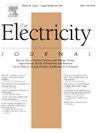Energy storage as a transmission asset: Definitions and use cases
IF 2.2
Q1 Social Sciences
引用次数: 0
Abstract
There is growing interest in deploying energy storage as a transmission asset (SATA), as evidenced by an evolving body of supportive policies and regulations and an expanding body of literature on the topic. Despite nearly two decades of evolution, however, transmission planning processes in the United States rarely consider storage alternatives and only a handful of projects have been selected. Regulators have assigned the responsibility of proposing non-transmission alternatives to non-utility participants in the planning process, so the sparse record of SATA projects may therefore result from a lack of specificity about the use cases for SATA and uncertainty about when it should be proposed. Extensive literature has been devoted to the topic of SATA, but much of it relies on definitions that are inconsistent with regulatory precedent and that exacerbate confusion. This paper reviews regulatory proceedings to define three types of energy storage assets than can interact with the transmission system: storage as a transmission asset, storage in place of a transmission asset (SIPTA), and dual-use energy storage. It then provides an inventory of use cases for SATA and SIPTA projects, using brief case studies to illustrate each use case. By clarifying the definition of SATA and its roles in transmission system planning, this work may be of use to transmission system planners and other participants in transmission planning processes to identify situations in which SATA alternatives merit consideration.
作为输电资产的储能:定义和使用案例
人们对将储能作为输电资产(SATA)进行部署的兴趣与日俱增,这体现在不断发展的支持性政策和法规,以及有关该主题的文献数量不断增加。然而,尽管经历了近二十年的发展,美国的输电规划过程却很少考虑储能替代方案,只有少数项目被选中。监管机构将提出非输电替代方案的责任分配给了规划过程中的非公用事业参与者,因此 SATA 项目的记录稀少可能是由于对 SATA 的使用案例缺乏明确性,以及对何时应该提出 SATA 的不确定性造成的。关于 SATA 的主题已有大量文献,但其中大部分依赖于与监管先例不一致的定义,这加剧了混淆。本文回顾了监管程序,以定义可与输电系统互动的三类储能资产:作为输电资产的储能、代替输电资产的储能 (SIPTA) 以及两用储能。然后,报告提供了 SATA 和 SIPTA 项目的用例清单,并使用简要案例研究来说明每种用例。通过澄清 SATA 的定义及其在输电系统规划中的作用,本报告可帮助输电系统规划人员和输电规划流程的其他参与者确定在哪些情况下值得考虑 SATA 替代方案。
本文章由计算机程序翻译,如有差异,请以英文原文为准。
求助全文
约1分钟内获得全文
求助全文
来源期刊

Electricity Journal
Business, Management and Accounting-Business and International Management
CiteScore
5.80
自引率
0.00%
发文量
95
审稿时长
31 days
期刊介绍:
The Electricity Journal is the leading journal in electric power policy. The journal deals primarily with fuel diversity and the energy mix needed for optimal energy market performance, and therefore covers the full spectrum of energy, from coal, nuclear, natural gas and oil, to renewable energy sources including hydro, solar, geothermal and wind power. Recently, the journal has been publishing in emerging areas including energy storage, microgrid strategies, dynamic pricing, cyber security, climate change, cap and trade, distributed generation, net metering, transmission and generation market dynamics. The Electricity Journal aims to bring together the most thoughtful and influential thinkers globally from across industry, practitioners, government, policymakers and academia. The Editorial Advisory Board is comprised of electric industry thought leaders who have served as regulators, consultants, litigators, and market advocates. Their collective experience helps ensure that the most relevant and thought-provoking issues are presented to our readers, and helps navigate the emerging shape and design of the electricity/energy industry.
 求助内容:
求助内容: 应助结果提醒方式:
应助结果提醒方式:


